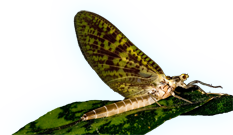Blog & Latest Updates
Fly Fishing Articles
Insects by Common Name

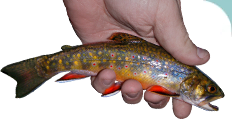
Stonefly Family Perlodidae (Springflies and Yellow Stones)
Taxonomic Navigation -?-
Kingdom
Animalia (Animals)
» Phylum
Arthropoda (Arthropods)
» Class
Insecta (Insects)
» Order
Plecoptera (Stoneflies)
» Family Perlodidae (Springflies and Yellow Stones)
20 genera aren't included.
Common Names
| Match | Common Name |
| Springflies and Yellow Stones | |
| Medium Browns and Yellows |
This is page 3 of specimens of Perlodidae. Visit the main Perlodidae page for:
- The behavior and habitat of Perlodidae.
Pictures of 27 Stonefly Specimens in the Family Perlodidae:
Megarcys subtruncata (Springfly) Stonefly Adult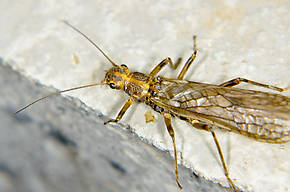 View 1 Pictures
View 1 Pictures
 View 1 Pictures
View 1 PicturesCollected June 25, 2011 from the Touchet River in Washington
Added to Troutnut.com by Bnewell on June 26, 2011
Added to Troutnut.com by Bnewell on June 26, 2011
Female Kogotus nonus Stonefly Adult View 18 Pictures
View 18 Pictures
 View 18 Pictures
View 18 PicturesCollected July 28, 2019 from Mystery Creek #199 in Washington
Added to Troutnut.com by Troutnut on July 30, 2019
Added to Troutnut.com by Troutnut on July 30, 2019
Osobenus yakimae Stonefly Nymph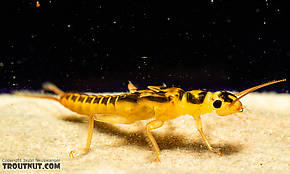 View 6 PicturesThis nymph keys out to Osobenus yakimae, and a comparison of the markings with a specimen on flyfishingentomology.com (http://www.flyfishingentomology.com/WAStoneflyDescription.php?Fa=Perlodidae&Ge=Osobenus) provides a good verification.
View 6 PicturesThis nymph keys out to Osobenus yakimae, and a comparison of the markings with a specimen on flyfishingentomology.com (http://www.flyfishingentomology.com/WAStoneflyDescription.php?Fa=Perlodidae&Ge=Osobenus) provides a good verification.
 View 6 PicturesThis nymph keys out to Osobenus yakimae, and a comparison of the markings with a specimen on flyfishingentomology.com (http://www.flyfishingentomology.com/WAStoneflyDescription.php?Fa=Perlodidae&Ge=Osobenus) provides a good verification.
View 6 PicturesThis nymph keys out to Osobenus yakimae, and a comparison of the markings with a specimen on flyfishingentomology.com (http://www.flyfishingentomology.com/WAStoneflyDescription.php?Fa=Perlodidae&Ge=Osobenus) provides a good verification.Collected June 13, 2019 from the South Fork Snoqualmie River in Washington
Added to Troutnut.com by Troutnut on June 14, 2019
Added to Troutnut.com by Troutnut on June 14, 2019
Kogotus nonus Stonefly Nymph View 9 PicturesAlthough Kogotus and Rickeri nymphs may be difficult or impossible to tell apart, I captured an adult Kogotus nonus specimen in the air on the same day as several of these nymphs, and they are likely the same species.
View 9 PicturesAlthough Kogotus and Rickeri nymphs may be difficult or impossible to tell apart, I captured an adult Kogotus nonus specimen in the air on the same day as several of these nymphs, and they are likely the same species.
 View 9 PicturesAlthough Kogotus and Rickeri nymphs may be difficult or impossible to tell apart, I captured an adult Kogotus nonus specimen in the air on the same day as several of these nymphs, and they are likely the same species.
View 9 PicturesAlthough Kogotus and Rickeri nymphs may be difficult or impossible to tell apart, I captured an adult Kogotus nonus specimen in the air on the same day as several of these nymphs, and they are likely the same species.Collected July 28, 2019 from Mystery Creek #199 in Washington
Added to Troutnut.com by Troutnut on July 30, 2019
Added to Troutnut.com by Troutnut on July 30, 2019
Isoperla fusca (Yellow Sally) Stonefly Nymph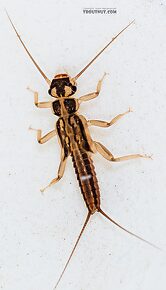 View 12 PicturesThis specimen keys to Isoperla fusca using the key in Szczytko & Stewart 1979, but some species of Isoperla weren't represented there.
View 12 PicturesThis specimen keys to Isoperla fusca using the key in Szczytko & Stewart 1979, but some species of Isoperla weren't represented there.
 View 12 PicturesThis specimen keys to Isoperla fusca using the key in Szczytko & Stewart 1979, but some species of Isoperla weren't represented there.
View 12 PicturesThis specimen keys to Isoperla fusca using the key in Szczytko & Stewart 1979, but some species of Isoperla weren't represented there.Collected April 9, 2021 from the Yakima River in Washington
Added to Troutnut.com by Troutnut on April 12, 2021
Added to Troutnut.com by Troutnut on April 12, 2021
Female Isoperla fusca (Yellow Sally) Stonefly Adult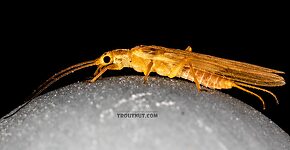 View 13 PicturesThe family ID on this one was a little bit tricky. Just going by the size, shape, and color, it looks like Chloroperlidae. However, the second anal vein of the forewing is does not appear to be forked, and the apical (Apical: Close to the apex; tip or end.) maxillary palpal segment is close to the length of the penultimate segment, both of which rule out that family. The position of the cubitoanal crossvein (Crossvein: Short cross-wise veins in an insect wing which connect the long longitudinal (length-wise) veins.) relative to the anal cell in the forewing -- touching it in this case -- indicates Perlidae (and it really doesn't have the "look" of Perlidae at all), but other characteristics, such as the metathorastic sternacostal sutures and lack of gill remnants, point to Perlodidae. That's the right answer. Moving on to Perlodidae, the key characteristics in Merritt & Cummins lead straightforwarly to Isoperla, and the species key in Jewett 1959 (The Stoneflies of the Pacific Northwest) leads to Isoperla fusca.
View 13 PicturesThe family ID on this one was a little bit tricky. Just going by the size, shape, and color, it looks like Chloroperlidae. However, the second anal vein of the forewing is does not appear to be forked, and the apical (Apical: Close to the apex; tip or end.) maxillary palpal segment is close to the length of the penultimate segment, both of which rule out that family. The position of the cubitoanal crossvein (Crossvein: Short cross-wise veins in an insect wing which connect the long longitudinal (length-wise) veins.) relative to the anal cell in the forewing -- touching it in this case -- indicates Perlidae (and it really doesn't have the "look" of Perlidae at all), but other characteristics, such as the metathorastic sternacostal sutures and lack of gill remnants, point to Perlodidae. That's the right answer. Moving on to Perlodidae, the key characteristics in Merritt & Cummins lead straightforwarly to Isoperla, and the species key in Jewett 1959 (The Stoneflies of the Pacific Northwest) leads to Isoperla fusca.
There is one caveat: That source does suggest a May-July emergence, whereas this one was collected in mid-September.
 View 13 PicturesThe family ID on this one was a little bit tricky. Just going by the size, shape, and color, it looks like Chloroperlidae. However, the second anal vein of the forewing is does not appear to be forked, and the apical (Apical: Close to the apex; tip or end.) maxillary palpal segment is close to the length of the penultimate segment, both of which rule out that family. The position of the cubitoanal crossvein (Crossvein: Short cross-wise veins in an insect wing which connect the long longitudinal (length-wise) veins.) relative to the anal cell in the forewing -- touching it in this case -- indicates Perlidae (and it really doesn't have the "look" of Perlidae at all), but other characteristics, such as the metathorastic sternacostal sutures and lack of gill remnants, point to Perlodidae. That's the right answer. Moving on to Perlodidae, the key characteristics in Merritt & Cummins lead straightforwarly to Isoperla, and the species key in Jewett 1959 (The Stoneflies of the Pacific Northwest) leads to Isoperla fusca.
View 13 PicturesThe family ID on this one was a little bit tricky. Just going by the size, shape, and color, it looks like Chloroperlidae. However, the second anal vein of the forewing is does not appear to be forked, and the apical (Apical: Close to the apex; tip or end.) maxillary palpal segment is close to the length of the penultimate segment, both of which rule out that family. The position of the cubitoanal crossvein (Crossvein: Short cross-wise veins in an insect wing which connect the long longitudinal (length-wise) veins.) relative to the anal cell in the forewing -- touching it in this case -- indicates Perlidae (and it really doesn't have the "look" of Perlidae at all), but other characteristics, such as the metathorastic sternacostal sutures and lack of gill remnants, point to Perlodidae. That's the right answer. Moving on to Perlodidae, the key characteristics in Merritt & Cummins lead straightforwarly to Isoperla, and the species key in Jewett 1959 (The Stoneflies of the Pacific Northwest) leads to Isoperla fusca. There is one caveat: That source does suggest a May-July emergence, whereas this one was collected in mid-September.
Collected September 17, 2020 from the Yakima River in Washington
Added to Troutnut.com by Troutnut on September 19, 2020
Added to Troutnut.com by Troutnut on September 19, 2020
Female Pictetiella expansa Stonefly Adult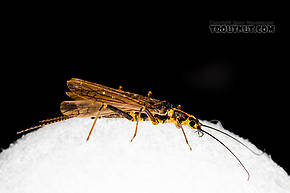 View 12 PicturesBased on photos, this specimen seems to key out (using Merritt & Cummins 4th Edition) to Pictetiella expansa, but some of the characteristics aren't 100 % clear. However, that species is listed as occurring near Puget Sound and the head markings are similar to (albeit not a perfect match for) those of a male from Colorado in the scientific literature here: https://www.researchgate.net/figure/Head-and-pronotum (Pronotum: The top of the insect prothorax.)-dorsal (Dorsal: Top.)-Pictetiella-expansa-Boulder-Co-Colorado-North-Fork-Middle_fig1_315373449
View 12 PicturesBased on photos, this specimen seems to key out (using Merritt & Cummins 4th Edition) to Pictetiella expansa, but some of the characteristics aren't 100 % clear. However, that species is listed as occurring near Puget Sound and the head markings are similar to (albeit not a perfect match for) those of a male from Colorado in the scientific literature here: https://www.researchgate.net/figure/Head-and-pronotum (Pronotum: The top of the insect prothorax.)-dorsal (Dorsal: Top.)-Pictetiella-expansa-Boulder-Co-Colorado-North-Fork-Middle_fig1_315373449
 View 12 PicturesBased on photos, this specimen seems to key out (using Merritt & Cummins 4th Edition) to Pictetiella expansa, but some of the characteristics aren't 100 % clear. However, that species is listed as occurring near Puget Sound and the head markings are similar to (albeit not a perfect match for) those of a male from Colorado in the scientific literature here: https://www.researchgate.net/figure/Head-and-pronotum (Pronotum: The top of the insect prothorax.)-dorsal (Dorsal: Top.)-Pictetiella-expansa-Boulder-Co-Colorado-North-Fork-Middle_fig1_315373449
View 12 PicturesBased on photos, this specimen seems to key out (using Merritt & Cummins 4th Edition) to Pictetiella expansa, but some of the characteristics aren't 100 % clear. However, that species is listed as occurring near Puget Sound and the head markings are similar to (albeit not a perfect match for) those of a male from Colorado in the scientific literature here: https://www.researchgate.net/figure/Head-and-pronotum (Pronotum: The top of the insect prothorax.)-dorsal (Dorsal: Top.)-Pictetiella-expansa-Boulder-Co-Colorado-North-Fork-Middle_fig1_315373449Collected June 16, 2018 from the South Fork Snoqualmie River in Washington
Added to Troutnut.com by Troutnut on July 3, 2018
Added to Troutnut.com by Troutnut on July 3, 2018
Isoperla fulva (Yellow Sally) Stonefly Adult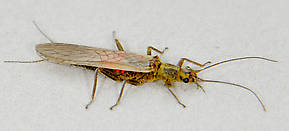 View 4 PicturesAn adult stonefly carrying a load of red mites.
View 4 PicturesAn adult stonefly carrying a load of red mites.
 View 4 PicturesAn adult stonefly carrying a load of red mites.
View 4 PicturesAn adult stonefly carrying a load of red mites.Collected May 31, 2011 from the Touchet River in Washington
Added to Troutnut.com by Bnewell on June 27, 2011
Added to Troutnut.com by Bnewell on June 27, 2011
Male Isoperla fulva (Yellow Sally) Stonefly Adult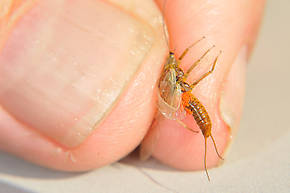 View 2 PicturesThese Isoperla are loaded with red parasitic mites.
View 2 PicturesThese Isoperla are loaded with red parasitic mites.
 View 2 PicturesThese Isoperla are loaded with red parasitic mites.
View 2 PicturesThese Isoperla are loaded with red parasitic mites.Collected June 6, 2011 from the Touchet River in Washington
Added to Troutnut.com by Bnewell on June 26, 2011
Added to Troutnut.com by Bnewell on June 26, 2011
Isoperla quinquepunctata (Little Yellow Stonefly) Little Yellow Stonefly Nymph View 2 PicturesSize - (excluding tails) - 10 mm
View 2 PicturesSize - (excluding tails) - 10 mm
Status at time of photo - preserved but no discernible color change as specimen was captured only a few days earlier.
Key characters - unique pattern on dorsal (Dorsal: Top.) head and thorax (Thorax: The thorax is the middle part of an insect's body, in between the abdomen and the head, and to which the legs and wings are attached.); dark medial (Medial: Toward the middle of the body.) terga (Tergum: the dorsal part of an abdominal segment or segments (terga). Also used to describe the entire abdominal dorsum or the thoracic dorsal segments of Odonata.) stripe between two paler stripes
This species is very common in west slope north Sierra watersheds. Richard W. Baumann & Boris C. Kondratieff did a study on the same section and at the same time of year (APRIL 25-29, 2010) where this specimen was taken. No other species of Isoperla were reported from this location and quinquepunctata was very abundant. Their hatches can be very heavy some Springs.
Entoman
 View 2 PicturesSize - (excluding tails) - 10 mm
View 2 PicturesSize - (excluding tails) - 10 mmStatus at time of photo - preserved but no discernible color change as specimen was captured only a few days earlier.
Key characters - unique pattern on dorsal (Dorsal: Top.) head and thorax (Thorax: The thorax is the middle part of an insect's body, in between the abdomen and the head, and to which the legs and wings are attached.); dark medial (Medial: Toward the middle of the body.) terga (Tergum: the dorsal part of an abdominal segment or segments (terga). Also used to describe the entire abdominal dorsum or the thoracic dorsal segments of Odonata.) stripe between two paler stripes
This species is very common in west slope north Sierra watersheds. Richard W. Baumann & Boris C. Kondratieff did a study on the same section and at the same time of year (APRIL 25-29, 2010) where this specimen was taken. No other species of Isoperla were reported from this location and quinquepunctata was very abundant. Their hatches can be very heavy some Springs.
Entoman
Collected March 21, 2011 from the Lower Yuba River in California
Added to Troutnut.com by Entoman on November 1, 2011
Added to Troutnut.com by Entoman on November 1, 2011
Top 10 Fly Hatches
Top Gift Shop Designs
Eat mayflies.
Top Insect Specimens
Miscellaneous Sites
Troutnut.com is copyright © 2004-2024 Jason
Neuswanger (email Jason). See my FAQ for information about use of my images.
 privacy policy
privacy policy
